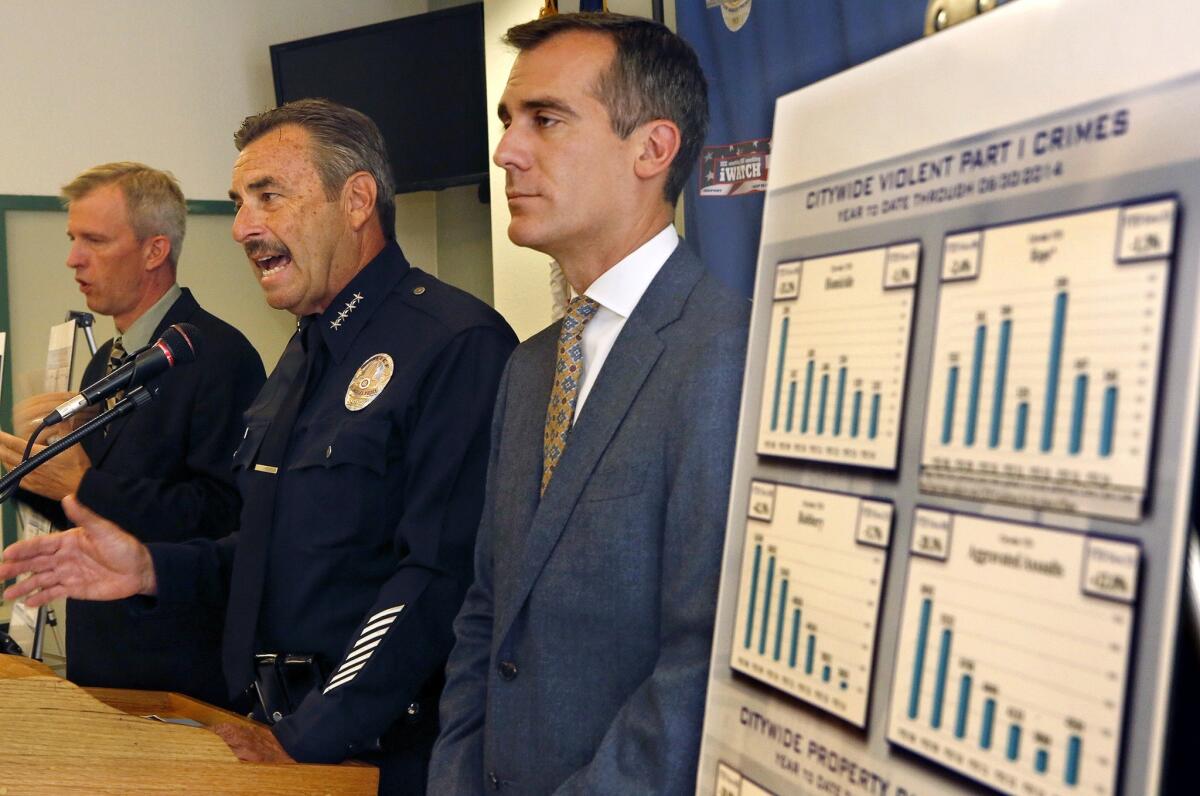LAPD’s misclassified incidents: How we reported this story

- Share via
Through the California Public Records Act, The Times obtained computerized crime data for more than 94,000 incidents recorded by the Los Angeles Police Department in the year ending Sept. 30, 2013.
The data were from the LAPD’s Consolidated Crime Analysis Database and included information on serious crimes such as aggravated assault, burglary and robbery, and minor crimes such as simple assault, theft and vandalism. The information included the time, date and location of each incident as well as a short summary of what happened. The data also showed the crime classification police assigned to each incident.
Times reporters read thousands of the summaries. They then compared the LAPD classifications with the FBI’s Uniform Crime Reporting handbook, which police departments are supposed to follow in classifying crime.
The Times concluded that the LAPD had misclassified nearly 1,200 serious violent crimes as minor offenses. Almost 600 serious property crimes also were misclassified. Unlike with violent crime, however, these errors had a negligible impact on the city’s official property crime rate.
The review found 31 cases of over-reporting — minor crimes that were incorrectly counted as aggravated assaults and robberies. Those findings are reflected in The Times’ calculations.
Reporters also reviewed court and internal police records for dozens of cases.
::
After compiling an initial list of misclassified crimes, The Times sought to verify its findings. Reporters shared a random sample of 400 of the incidents with five independent crime-coding experts.
They were: Dan Bibel, program manager for the Massachusetts State Police Crime Reporting Unit; Jeffrey Bock, manager of the crime reporting program for the Oregon State Police; Monica Jenkins, manager for the Michigan State Police crime reporting program; Gary Lopez, former director of the Connecticut State Police Crime Analysis Unit; and Max Schlueter, former director of the crime reporting program at the Vermont Department of Public Safety.
The sample was divided among the five experts. In 90% of the cases reviewed, they agreed with The Times’ conclusion that the crimes had been misclassified. They disagreed with The Times in some cases, saying more information was required to make a judgment. All of those cases, as well as any cases with similar characteristics, were discarded from The Times’ count of misclassified crimes.
The Times asked the FBI’s Criminal Justice Information Services Division to review a sample of cases. The FBI declined the request.
When The Times presented its findings to the LAPD, Deputy Chief Rick Jacobs, who oversees the department’s CompStat program, raised concerns that the short summaries of crimes were not accurate. To address that concern, The Times gave the department a random sample of 200 assaults that appeared to have been misclassified.
Department officials initially disagreed with The Times on nearly a third of the incidents in the sample and provided redacted copies of police reports from those cases. The Times reviewed the reports and shared them with three of the outside crime-coding experts consulted earlier. The Times ultimately concluded the LAPD had misclassified 88.5% of the aggravated assaults in the sample.
To account for the cases in the sample that were found to be classified correctly, The Times reduced its overall count of misclassified aggravated assaults by 11.5%.
After consulting their own crime classification expert, LAPD officials eventually dropped their earlier objections to The Times’ findings and acknowledged that 88.5% of the sample was misclassified. Jacobs said the errors would be corrected.
Large gaps were found in the LAPD’s crime database. More than 25% of the incidents for which the department provided data were missing narrative descriptions, making it impossible to assess whether those incidents had been categorized correctly.
The Times also requested crime reporting information dating to 2000 to evaluate the accuracy of the LAPD’s statistics over time. Department officials rejected the request, instead providing only records from the most recent six-month period. The Times filed two requests to build its one-year sample.
More to Read
Sign up for Essential California
The most important California stories and recommendations in your inbox every morning.
You may occasionally receive promotional content from the Los Angeles Times.















